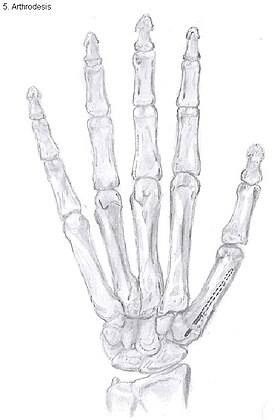
Back إيثاق المفصل Arabic Artròdesi Catalan Arthrodese German Artrodesis Spanish خشک کردن مفصل Persian Luudutusleikkaus Finnish Arthrodèse French Artrodeza Croatian Artrodesi Italian Artrodese Dutch
| Arthrodesis | |
|---|---|
 Arthrodesis of the thumb | |
| ICD-9-CM | 81.0-81.3 |
| MeSH | D001174 |
Arthrodesis, also known as artificial ankylosis or syndesis, is the artificial induction of joint ossification between two bones by surgery. This is done to relieve intractable pain in a joint which cannot be managed by pain medication, splints, or other normally indicated treatments. The typical causes of such pain are fractures which disrupt the joint, severe sprains, and arthritis. It is most commonly performed on joints in the spine, hand, ankle, and foot. Historically, knee and hip arthrodeses were also performed as pain-relieving procedures, but with the great successes achieved in hip and knee arthroplasty, arthrodesis of these large joints has fallen out of favour as a primary procedure, and now is only used as a procedure of last resort in some failed arthroplasties.[citation needed]